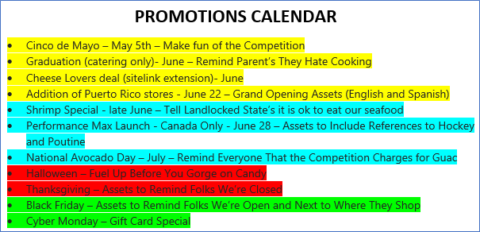Hello, my dear fellow search marketer, and welcome to 2023.
It’s time to make some New Year’s resolutions, or at the very least, be prepared to make some changes for the new year.
Unlike my New York Jets, there is ample opportunity to drop the crappy “guru” you’ve hired, forecast out a budget (even in a recession), play with a new bid strategy, make memes about Performance Max/GA4 and give Bing (I still refuse to call it Microsoft Advertising) the fighting chance it deserves.
Also, don’t forget to migrate your Twitter ad budget to something actually stable.
So, let’s discuss what you should be doing now, what you went through in 2022, and what you need to do in 2023.
Think of this as a really nerdy and “snarkastic” visitation of three ghosts.
What Should You Be Doing Right Now?
It’s the beginning of 2023, so you’re running a bit late – but you can still make up for lost time.
Forecasting A 2023 Budget
You’ve seen how to forecast search budgets year after year: the old “determine impression share (IS) lost due to budget and had 3%-5% increase in CPC assuming strategy stays the same” method.
Then the pandemic came along, and forecasting got a little iffier. Now, that method lacks some weight.
The reality is, if you keep with that approach, fine, not the end of the world, but understand that cost per click (CPC) growth, especially on brand terms, saw some obscene growth in 2022 (starting around April).
Why? There are a variety of theories, but for now, let’s just call it “inflation.”
If you keep the typical approach, expect to add anywhere from 10%-15% on brand CPC growth YoY in Q1 and, likely, more along the lines of 4%-7% growth on non-brand. This comes from our own in-house estimate – yours should vary.
Next, the ugly elephant in the room – Performance Max – appears. But it gets more complicated if you migrate smart shopping over to Performance Max as well.
There are two ways to forecast this, and honestly, neither will be all that accurate or insightful – I apologize in advance.
- Look at Google’s recommendation tool, see what it says for growth on a budget (because we all know it never says less), take 15%-25% off that growth level (kill off the buffer), and try that.
- Or, gradually scale upward of 5%-10% from your current budget, assuming you hit budget caps consistently while flexing up and down for seasonality.
As I said, neither option is great.
If you want to adjust your search strategy (not applicable for Performance Max), look at your IS lost to rank and work the fancy formula that PPC Hero posted a little ways back.
It’ll help you understand where your current strategy/bids are, causing you to miss opportunities.
This is a good time to pace out your budget (if you’re like me, you have a planned budget to spend for literally every day of the year, which will vary based on anticipated demand).
Content Calendar/Seasonal Flighting Planning
Often this is not as applicable if you’re new to a piece of business, but it should 100% be part of your plan.
If you aren’t new to the business and you haven’t done this, then you are Mr. Wilson of the Jets and deserve to be benched.
Make sure you know your deals, seasonality for peaks and lows, and everything you want to do creatively and budget-wise.
It allows you to get all of your assets built way in advance, approved, and scheduled for deployment.
-
 Screenshot from author, December 2022
Screenshot from author, December 2022
Assessing What You Didn’t Do
Life and work get busy. This happens to all of us. Odds are, you had laid out some plans for 2022 that you could not execute.
Now is the time to determine what builds, testing, flighting plans, etc., you never got around to doing last year and reprioritize them to determine if you should try them out in 2023.
I like to use this thought process when doing that evaluation:
Was this for “fun” or a necessity (i.e., Is this effort something that would’ve definitely made a business impact, or something just to try out and see if it could help or hurt)?
- If it was a necessity, then I hope you have a good excuse for why it wasn’t done and put it on the books for 2023.
- If it was for “fun,” file it away for a rainy day.
Was there a business implication (positive or negative) by not doing this?
- If no, then no harm/no foul, and you can try it eventually.
- If yes, then get it ready for 2023, and have a good explanation as to why it wasn’t done.
Consider what you’ve been through.
Much like dealing with your strange aunt/uncle who said something grossly inappropriate during the holidays, you need to sit down and process what did happen to your SEM campaigns in 2022.
This helps you decide if it was all good, all bad, or somewhere in between and what you need to consider carefully in 2023.
Look at both the big things and the small things.
Performance Max
If you migrated into Performance Max by choice or by force (anyone using Smart Shopping or local search), it likely made both a negative and a positive impact on your year.
Negative: You literally have no idea when/where your ad is showing, and all you can think (and you’re probably right) is that Google has thrown some of your direct-to-consumer (DTC) funds away on a really bad Google Display Network placement.
At the same time, you have very little information or ability to explain to your boss why Google has basically relaunched the SMB-targeted Adwords Express as a 2.0 version and just ruined your transparency.
Negative: You did the auto upgrade of a local campaign to Performance Max and discovered how many bugs there are, or you let Google create your YouTube video, and the music makes it far more cringe than you had hoped.
Positive: Especially for those running foot traffic campaigns, you’ve (hopefully) seen cost per store visits become somewhat more cost-efficient, and your ecommerce (for those running Smart Shopping) has seen an improvement in the cost per action (CPA).
Positive: Performance Max is slowly becoming more reliable, and the ability to move to other verticals that are leads driven has become an opportunity.
Google Analytics 4 (GA4)
I’ll go ahead and say what we’re all thinking (and it has been published multiple times already):
My god, this analytics platform was clearly made by someone who clearly only interacts with barnyard animals and has a vision and not by someone who did a user focus group.
If you somehow managed to survive the implementation of GA4, you’re now, more than likely, cursing it out due to lack of intuitiveness or more frustrated they rolled it out without a bounce rate or even conversion rate until months later.
All is not lost, though; I highly recommend deploying it immediately (if you haven’t already) and running it concurrently with GA UA, so you can work out the kinks and learn the platform while accruing historical data.
You may feel like Google decided to wake up and choose chaos with this platform and probably lost a few weeks of your life trying to understand it – so keep it in mind when you evaluate what you didn’t get around to doing in 2022.
Bing Multimedia Ads
You saw the hype for them in September, especially on the video side, and thought: Finally, Bing is getting into the video ad game.
But then you realized you needed a raw video file to upload it and how little it would rotate.
Big hopes, big opportunity, but just no volume.
I know this article is SEM focused, but I would be remiss if I didn’t address this, as it is still biddable media.
Every brand has different views on brand association, but if you have even a hint of brand safety concerns on GDN, MSAN, YouTube, etc., then do not advertise on Twitter until it gets itself straightened out.
Some of these changes in 2022 impacted you in different ways, good or bad.
The question is, can you learn from them, use them, and progress in 2023, with or without them?
What You Need to Do In 2023
I’ve done several of these “What to Expect in the New Year for SEM” articles over the years, but the last two of these could never have anticipated what is going on now… again.
With that being said, I will go with what I believe is mostly going to happen, and you can take it with a grain of salt:
- The NY Jets will not make the big game – just accept it.
- CPCs, especially for Q1, will be higher than any other Q1 on record (especially brand terms), so be prepared to find a way to explain why and for your money make to become less cost-efficient.
- There will not be a decline in demand/search volume until there is an increase in unemployment (ala 2007-2009 recession), so be prepared to address the uptick in volume.
- Google will become less transparent, somehow.
- Bing will eventually do whatever Google does.
- If you work with healthcare brands, prepare to get rid of GA UA quickly due to HIPAA compliance.
- Absolutely most important, use 1st party data as long as you can – but you need to get extremely good, and fast, at building in market audience segment groups and go all Criminal Minds/FBI profiling a serial killer mentality on targeting.
Have I scared you yet? Good.
2023 will be a wild year in search, and you must be prepared for it.
But you cannot move forward until you evaluate and process the past. Once that is done, you can plan out the future.
Best of luck, search marketers. We’re all going to need it.
More resources:
- 6 SEM Best Practices Growth Marketers Need To Master
- Picking The Right SEM Operation: Legits Vs. Hacks
- The Biggest PPC Trends of 2023, According to 22 Experts
Featured Image: 3rdtimeluckystudio/Shutterstock





